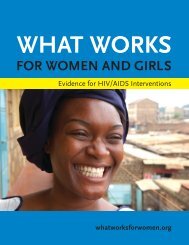Global Tuberculosis Report -- 2012.pdf
Global Tuberculosis Report -- 2012.pdf
Global Tuberculosis Report -- 2012.pdf
Create successful ePaper yourself
Turn your PDF publications into a flip-book with our unique Google optimized e-Paper software.
spline interpolation. If only one prevalence survey measurementwas available, time-trends were assessed usingin-depth analysis of surveillance data, as described above.In this report, the prevalence to incidence method wasused for three countries: Ethiopia, Laos and Viet Nam.4.4 Disaggregations of TB incidenceIn this report, TB incidence is only disaggregated by HIVinfectionstatus (see following section). The estimation ofsmear-positive TB incidence was discontinued in 2010,for reasons explained in detail in the global report publishedin 2010.4.5 Estimates of HIV prevalence among incident TBcases, 1990–2011The prevalence of HIV among incident cases of TB wasdirectly estimated from country-specific and empiricaldata wherever possible, with missing data imputed to completetime series using methods similar to those describedin Section 3.1. For the estimates published in this report,suitable data (as defined in Table A1.4) were available fora total of 639 country-year data points. When data fromseveral data sources were available for the same countryyear,one source was retained based on knowledge aboutthe underlying quality of data, consistency with adjacenttime points or with expectations. In general, nationalsurveys of HIV prevalence in newly detected TB casestook precedence over the other two sources unless thereported numbers were judged not plausible (in generaldue to data entry errors that could not be corrected intime for use in this report). The least reliable data sourcewas considered to be HIV sentinel surveillance systems asthese do not generally provide nationally representativedata on TB cases.TABLE A1.4Sources of data on HIV prevalence amongincident TB casesDIRECT MEASUREMENT OF THE PREVALENCE OF HIV IN TB PATIENTSNUMBER OF COUNTRY-YEARSNational surveys 20HIV sentinel surveillance 26Provider-initiated testing and counselling withat least 50% coverage of testing593Total 639Provider-initiated testing and counselling with at least50% HIV testing coverage is the most widely availablesource of information on the prevalence of HIV in TBpatients. However, this source of data is affected by biases,particularly when coverage is closer to 50% than to100%. In all countries with repeat data from testing, therelationship between the prevalence of HIV in TB patientsand the coverage of HIV testing was examined graphically.In some countries, the prevalence of HIV in TBpatients was found to decrease with increasing HIV testingcoverage while in others it increased with increasingHIV testing coverage; in most countries, the prevalenceof HIV followed highly inconsistent patterns (with repeatchanges in direction) as HIV testing coverage increased.Therefore, it was not possible to adjust for the effect ofincomplete coverage of HIV testing on estimates of theprevalence of HIV among TB patients. The assumptionwas thus made that TB patients with an HIV test resultwere statistically representative of all TB cases. As coverageof HIV testing continues to increase globally, biaseswill decrease.For the 4047 country-year data points for which surveillancedata were either not available or for which thepercentage of TB patients tested for HIV was below 50%,the prevalence of HIV was estimated indirectly accordingto the following equation:ht =l + h( – l)In this equation, t is HIV prevalence among incident TBcases, h is HIV prevalence among the general population(from the latest time-series provided by UNAIDS) and ρis the incidence rate ratio (IRR) (defined as the incidencerate of TB in HIV-positive people divided by the incidencerate of TB in HIV-negative people). We then let logit(t) belog(t/(1-t)) and logit(h) be log(h/(1-h)). Using data fromcountries where HIV prevalence has been estimated byUNAIDS as an independent variable, a linear model oflogit-transformed t was fitted using logit-transformed haccording to the following equation, written in matrixnotation:ˆT = Xwhere ˆT is a vector of predicted logit(t), X is an n x 2matrix in which the first column holds 1s, and the secondcolumn holds logit(h). The vector β holds estimatedmodel parameters. Models were tested with lags set forlogit(h) ranging from no lag to a lag of 8 years. The best fitwas obtained with a lag of one year.Models were run using Monte Carlo simulations inwhich h was drawn randomly from a Beta distributionwith shape parameters computed as described in Section4.1, (low and high uncertainty bounds are providedby UNAIDS – also see Table A1.3). The model was run50 000 times using country-specific distributions for Hand T (noted in capital letters to denote vectors or matrices)based on their uncertainty intervals. The uncertaintybounds for β were chosen as the 2.5th and 97.5th centiles.The source of data used for each country is availableupon request from tbdata@who.int.100 GLOBAL TUBERCULOSIS REPORT 2012
















